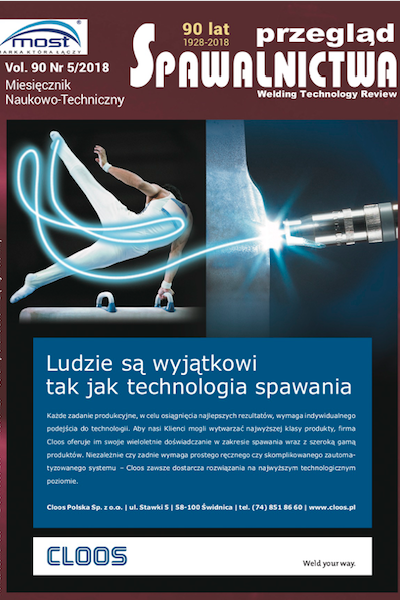The assessment of susceptibility to hot cracking under forced deformation conditions in welded joints of Inconel 617 alloy
Main Article Content
Abstract
The development of power industry depends on variety factors, which primarily include European Union policy that obliges the industry to reduce emission of NOX, CO2, SO2to the atmosphere. The increase of steam parameters is possible due to the use of advanced materials, which include nickel alloys. Despite their good mechanical proper- ties at high temperatures, nickel alloys are difficult to weld due to the occurrence of hot cracks in the weld and the heat affected zone (HAZ). The article presents the results of susceptibility to hot cracking of Inconel 617 alloy, which is intended for critical elements of power boiler. The investigations include technological welding tests during forced deformations in the presence of inert gas with a tungsten electrode. In Transvarestraint test the amount of determination and the high temperature brittleness threshold were determined. Additionally, microanalysis tests sheets from cracking area by light microscope (LM) and scanning electron microscope (SEM) were done.
Downloads
Article Details
Creative Commons CC BY 4.0 https://creativecommons.org/licenses/by/4.0/
Welding Technology Review (WTR) articles are published open access under a CC BY licence (Creative Commons Attribution 4.0 International licence). The CC BY licence is the most open licence available and considered the industry 'gold standard' for open access; it is also preferred by many funders. This licence allows readers to copy and redistribute the material in any medium or format, and to alter, transform, or build upon the material, including for commercial use, providing the original author is credited.
References
Hernas A., Dobrzański J., Pasternak J., Fudali S.: Charakterystyki nowej generacji materiałów dla energetyki, Wydawnictwo Politechniki Śląskiej, Gliwice, 2015.
Adamiec J.: Własności korozyjne napawanych warstw na elementach kotłów do spalania biomasy i odpadów komunalnych, w: Procesy niszczenia oraz powłoki ochronne stosowane w energetyce, s. 201-218, Słok k/ Bechłatowa,12-13 marca 2015.
Stewart C.: Nickel Based Super Alloys, pp. 1-9, INSG Insight, nr 20, 2013.
Klöwer J., Husemann R. U., Bader M.: Development of Nickel Alloys Based on Alloy 617 for Components in 700 °C Power Plants, Procedia Engineering, nr 55, pp. 226-331, 2013.
Liu W., Lu F., Yang R., Tang X., Cui H.: Gleeble simulation of the HAZ in Inconel 617 welding, Journal Materials Processing Technology, 225, pp. 221-228, 2015.
Pavan A.H.V., Vikrant K.S.N., Ravibharath R., Singh K.: Development and evaluation of SUS 304H IN 617 welds for advanced ultra supercritical boiler application, Materials Science & Engineering, 642, pp. 32-41, 2015.
Tasak E.: Metalurgia spawania, Wydawnictwo JAK, Kraków 2008.
Tasak E., Ziewiec A.: Pękanie spoin w procesie krzepnięcia, Przegląd Spawalnictwa, nr 1, s. 14-18, 2007.
Prokhorov N.N.: Russian Castings Production 2, 1962.
Lancaster J.F.: The metallurgy of welding, brazing and soldering, George Allen& Unwin Ltd, London 1965.
DuPont J., Lippold J., Kiser S.: Welding metallurgy and weldability of nickel-base alloys, John Wiley & Sons, New York, 2009.
Norma ASME SB-168:2013: Specification for nickel-chromium-iron alloys (UNS N06600, N06601, N06603, N06690, N06693, N06025, and N06045) and nickel-chromium-cobalt-molybdenum alloy (UNS N06617) plate, she- et and strip.
Adamiec J.: Spawalność odlewniczych stopów magnezu, Wydawnictwo Politechniki Śląskiej, Gliwice 2010.
